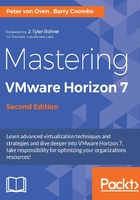
VMware User Environment Manager (UEM)
The VMware UEM product is a new edition to the Horizon portfolio and was added when VMware acquired the Dutch company Immidio back in February 2015. Immidio was a software company that created products that were aimed at helping their consultants out in the field, with the core product being called Flex+.
UEM adds additional functionality above the standard Persona Management solution, also providing a central management console, and delivers personalization of the end user's virtual desktop machine as well as the ability to dynamically configure policies. It works across a number of environments such as virtual desktop machines and physical PCs, as well as cloud-based Windows desktop environments.
Note
To manage a virtual desktop machine with UEM, you will need to install the FlexEngine components onto the virtual desktop machine. Make sure you include this as part of your master image or parent VM.
There are five key use cases that UEM can be used with:
- Application Configuration Management: Allows you to configure an application's initial settings rather than deploying the application's own default settings. You can configure predefined settings as one-time defaults, fully enforced (application starts with the user's personalized settings every time), or partially enforced (application starts as configured but allows the user to perform limited personalization), using the VMware UEM Application Profiler to capture predefined settings for an application.
- User Environment Settings: Allows you to centrally manage User Environment settings such as the following:
- Application blocking
- Application shortcuts and file type associations
- Drive and printer mappings
- Environment variables
- Files, folders, and registry settings
- Folder redirection
- Personalization: Abstracts user-specific desktop and application settings from the underlying OS and then makes these settings available across multiple devices, Windows versions, and applications. It also supports operating system migration such as Windows 7 or Windows 8.1.
- Application Migration: Allows an end user to effectively have roaming application and personalization settings that they can move between different operating system versions, such as Windows 7 to Windows 8.1.
- Dynamic Configuration: Using condition sets allow you to combine conditions based on variables such as user, location, and device, to deliver dynamic delivery of content and appearance. For example, delivering access to a network printer based on an end user's location, or create particular drive mapping that is based on the user's identity.
SmartPolicies
SmartPolicies is a feature of Horizon 7, and uses UEM 9.0 to deliver a set of policies that are specific to Horizon View virtual desktop machines.
Note
To use SmartPolicies, you need to make sure that the virtual desktop machines are running Horizon Agent 7.0 or later and VMware User Environment Manager 9.0.
With SmartPolicies, you can configure the following:
- USB redirection
- Printing
- Clipboard behavior
- Client drive redirection
- PCoIP profile
UEM or Persona Management?
So, the question is, which solution should you use? UEM is available as part of Horizon Enterprise Edition or as a standalone product, so that means higher or additional cost, unless of course you planned on purchasing Enterprise Edition in the first place.
UEM delivers a far greater set of configuration variables and features, as well as having a central management console that makes it far easier to manage and deploy. However, you may already have a more comprehensive UEM solution in place. If you are using a lesser edition of Horizon, then Persona Management may well deliver your requirements, and if not, then maybe it's worth considering a third-party product such as Liquidware Labs ProfileUnity or AppSense.